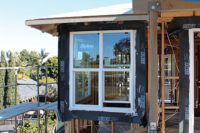
The landmark Olympia Theater and apartment building in Miami, a jewel of the South Florida arts and cultural community since 1926, was recently in a state of massive deterioration and disrepair. The historic 10-story high-rise complex was facing an uncertain future. Serious discussions would be required if an emergency and long-term repair solution wasn’t developed to address pressing structural and safety issues surrounding the building’s exterior brick masonry cladding and terra cotta façade.
A concerted $2.1 million restoration effort by the City of Miami and the Miami Parking Authority (which runs the theater) began when historic preservation and architecture design firm, R.J. Heisenbottle Architects, P.A. of Coral Gables, Fla. was brought in to head the restoration effort. RJHA President Richard Heisenbottle immediately consulted with the interdisciplinary structural engineering and architectural firm Wiss, Janney, Elstner Associates, Inc. of Northbrook, Ill. to conduct an initial onsite assessment.
The preliminary assessment was performed over two days in late October 2009 to investigate the buildings distresses and design an emergency stabilization procedure before installation of long-term repairs for the exterior masonry cladding could occur. WJE collaborated with industry leading masonry repair reinforcement system manufacturer Helifix Inc. of Streetsboro, Ohio to provide a supplementary and sustainable lateral and gravity support system for the building’s distressed veneer using its Helibeam System.


The key focus of the Helibeam System was the use of stainless steel (austenitic grade 304 or 316) HeliBars seven meters long to create a reinforced beam across each spandrel level to distribute and support the structural loads across the piers and into the steel lintels and spandrel beams.
HeliBar starts as round stainless steel wire with a typical 0.2 percent proof stress of 500N/mm². After the cold forming manufacturing process that creates the helical hi-fin design, the proof stress doubles to approximately 1100N/mm². This means that HeliBar, with its relatively small diameter, provides substantial tensile strength to masonry, particularly when combined with HeliBond grout which locks between the fins and bonds to the masonry.
Rounding out the Helibeam System, approximately 9,000 10 millimeter DryFix remedial ties were installed through the veneer and into the backup-providing lateral restraint and securing the façade.
SAVE BUILDINGS
According to WJE Associate Principal Brett Laureys, “The Helibeam System was specified because of its proven ability to secure existing masonry. It is fully concealed (once installed) and its flexibility allows it to be bent around corners with no loss of performance. It was also the most cost-effective stabilization method available and, with all work undertaken externally, there was minimal disruption to the upper floor tenants during this emergency restoration phase which overcame the veneer’s lack of support, securing the structure while full renovation of the Olympia Theatre was safely undertaken.”<

In conjunction with Helifix’s on-site quality control and assurance support team, installation of the Helibeam System at the Olympia Theater was conducted by industry leading specialty repair contracting company Structural Preservation Systems of Hanover, Md. To form the Helibeam System, two horizontal rows of 7-meter long stainless steel HeliBars were laid at various levels around the circumference of the building. This creates a deep masonry beam to distribute the structural load and provide gravitational support around the entire building.
Installation involved cutting out 1¾-inch deep slots in the mortar joints which were vacuumed and then flushed with water. A bead of thixotropic cementitious HeliBond grout was laid in and the 7-meter length of HeliBar was then placed in the slot. The grout-HeliBar-grout process was repeated on top to complete the composite action of the Helibeam System. When each length of HeliBar came to its end, the next length was overlapped to create one monolithic run around the building with corners kinked in at a 90-degree bend. The recessed Helibeam was then pointed over the top, rendering it virtually transparent to the naked eye upon completion.
Additionally, DryFix remedial ties used in tandem with Helibeam System for lateral restraint in the façade. The DryFix ties were installed by being power-driven into position via a small pilot hole using a special installation tool that leaves the end of the tie recessed below the outer face-allowing an invisible finish. Crack stitching was also conducted to secure local cracking and stabilize any further movement of separating brick areas. According to SPS Project Engineer/Manager Alan Fleischer, “The Helibeam installation was easy, as it’s a lot like crack stitching but in a longer run. After we completed the installation, you’d never know what was done to the building.”
THE RESULTS
The Helibeam System was installed within four months of WJE’s specification beginning with the anchors and completed in August 2010. An alternative to complete structural tear down and rebuild, the system delivered an efficient green solution in restoring the historic Olympia Theater. According to Helifix VP for North American Operations Reno Fricano, “Ultimately, in collaborating with WJE and SPS throughout the entire specification, design, and installation phases, the system provided a non-invasive, cost-effective, and sustainable stabilization solution in revitalizing the architectural luster and integrity to one of America’s original movie palaces.”
WJE’s Brett Laureys says, “The repairs were successfully installed, meeting the client’s needs of an emergency stabilization method which could be installed immediately, quickly, and inexpensively. It’s hard to compare with it as it was more cost effective than traditional stainless steel threaded rod and epoxy.”
Finally, RJHA’s Heisenbottle noted, “The initial emergency (Phase I) restoration looks beautiful and the team is proceeding with the final (Phase II) $10 million restoration of the theater side of the building and the terra cotta tower which should round out the project sometime in 2012.”






